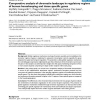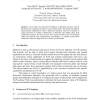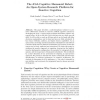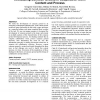500 search results - page 10 / 100 » Humans in the Process: Architectural Implications |
BMCBI
2005
13 years 8 months ago
2005
Background: Global regulatory mechanisms involving chromatin assembly and remodelling in the promoter regions of genes is implicated in eukaryotic transcription control especially...
FIW
2003
13 years 10 months ago
2003
A new feature set suited for IP telephony is described. The user value of this feature set is discussed in terms of social science results. This feature set supports natural human ...
AI50
2006
14 years 17 days ago
2006
Abstract. This paper describes a multi-disciplinary initiative to promote collaborative research in enactive artificial cognitive systems by developing the iCub : a open-systems 53...
CHI
2008
ACM
14 years 9 months ago
2008
ACM
We study the development of common ground in an emergency management planning task. Twelve three-person multi-role teams performed the task with a paper prototype in a controlled ...
ICMI
2004
Springer
14 years 2 months ago
2004
Springer
One of the implicit assumptions of multi-modal interfaces is that human-computer interaction is significantly facilitated by providing multiple input and output modalities. Surpri...




